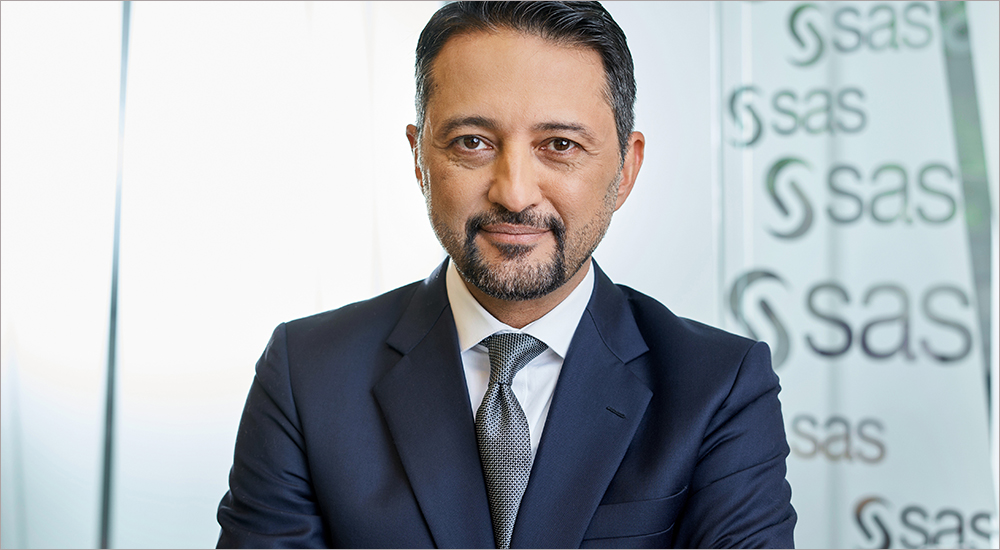Helping C-suite take charge of organisational transformation

While artificial intelligence has resurfaced as a recent buzzword, for global vendor SAS it is a 40+ year old core competence. SAS continues to focus on singular and advanced analytics and attracts global enterprises from this competence. As business industries have progressed into adopting digital transformation technologies, SAS has also developed its global partner alliances.
“We are always going to be working closely with different types of partners that have domain expertise. So, we are always looking to engage with partners with different areas of expertise in the area of banking, telecommunications, energy, and the public sector,” says Amir Sohrabi, Head of Business and Sales Operations, Middle East and Eastern Europe at SAS. He points out that SAS has never been more engaged with partners. “They are bringing a lot of value to our ecosystem, so that has just accelerated in the last few years.”
SAS’ strengths lies in its analytical and data ingestion capabilities and it is this strength that has attracted global industrial technology vendors like Honeywell to partner with SAS. Leveraging this strength, SAS has now created a global IoT division that did not exist even three years ago. SAS harvests the data coming from these industrial technology solutions and applies analytics on top of the data leading to better decision making.
A key strength of SAS’ IoT division is its fundamental ability in generating analytics from the edge to the core. While SAS’ legacy was analytics at the core, the recent developments of IoT sensors at the edge have meant that analytics have to be built into the edge as well. “We are the experts in the area of analytics and by embedding our analytics into their IoT devices, we will have this from edge to the core. This is how we are bridging the gap and helping our clients innovate their business,” elaborates Sohrabi.
Across the region, Sohrabi sees select industries, including utilities and energy, adopting faster than others in the region and in comparison, to their global counterparts as well. SAS is actively engaged in boosting the adoption rate of analytics across various industries in the region. “We look at those organisations as our IoT partners and we have a very strong IoT strategy in which we are engaged with them. We work very closely with strategic industries and strategic partnerships,” says Sohrabi.
Typically, there are three levels of analytics meant for operational analysts, managers, and top-level executives. Traditionally SAS has operated at the analyst level but is now delivering analytics for top level executives as well. In essence SAS has now developed into an end to end lifecycle, data analytics platform. Analysts work at the operational level of data and then push their results up the pyramid to the management level. The management level pushes their results to top level executives, who further utilise these analytics based on their required key performance indicators.
“The decision-making and the type of data they look at is going to be completely different from the managerial down to the analyst level and it is going to be the triangle feed that goes up there. That is where we can really hone in and be able to allow the executive to formulate the right type of analytics culture,” explains Sohrabi. “Our approach is really defining the business requirement of the executive layer.”
The way analytics is deployed and used at each of the three levels are vastly different from each other. By working at the executive level, SAS helps to identify what are the key drivers for business and what are the milestones they are trying to reach. SAS is engaged with its customers at the executive level to be able to define their strategy and usage of analytics for their business requirements.
From the beginning, the value proposition offered by SAS analytics has been tied to business. “All of our value propositions have solid business cases behind them and this is where always our focus has been. Our core strength has always been to be with business and to make sure that we are driving value for business,” points out Sohrabi.
But now with the adoption of digital technologies, Sohrabi describes the SAS go to market and positioning using a different analogy. He points out that, business data is like the fuel driving digital transformation of an organisation. And analytics is the heart and engine of an organisation’s digital transformation. “If we look at digital transformation, what is making it go – the fuel – is data. The engine is a strong analytical platform and for us that engine is the SAS platform. That is how we drive value for customers to be competitive, to innovate and to optimise.”
Another driver for digital transformation is the convergence of exponential growth rates of data, growth of compute power, in conjunction with the capability of software to analyse data. The exponential growth of data is helping to build more predictive models of analytics and algorithms. And according to Sohrabi, this is in reality a key driver for the growth of analytics. “How data is propagating and growing is exponentially – it is not sequential. That is creating a tremendous pool of data for clients to be able to leverage,” he says. The ability of the SAS analytics engine to ingest data from all types of sources is another key enabler.
SAS uses advanced analytics as part of the way of driving value for customers in their digital transformation journey. “We believe analytics and having an analytics culture is the heart of digital transformation,” reflects Sohrabi.
Key takeaways
- A key strength of SAS’ IoT division is its ability in generating analytics from the edge to the core.
- Select industries, including utilities and energy, are adopting analytics faster than others in the region.
- SAS is engaged with customers at executive level to be able to define strategy and usage of analytics.
- Business data is like the fuel driving digital transformation of an organisation.
- Analytics is the heart and engine of an organisation’s digital transformation.
- The exponential growth of data is helping to build more predictive models of analytics and algorithms.
- SAS uses advanced analytics as part of driving value for customers in their digital transformation journey.





